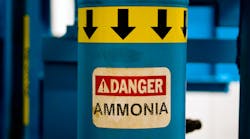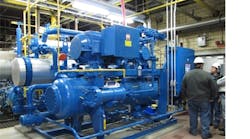Manufacturers and researchers always are looking for the next big thing. In the HVACR realm, something with the potential to be the next big thing is something that’s actually been in use for more than a century: ammonia.
“With the current flux in the refrigeration industry, with refrigerants being phased out and new ones coming on, and with the uncertainty, ammonia is a refrigerant that’s been around for well over 100 years in all sorts of applications,” says Dan Dettmers, an associate researcher for the Industrial Refrigeration Consortium and the HVAC&R Center at the University of Wisconsin-Madison. “It’s environmental and human risk factors are well understood, and it’s a very efficient refrigerant,” Dettmers says.
According to the International Institute of Ammonia Refrigeration (IIAR), ammonia is a common, naturally-occurring compound in the environment and is among the most abundant gasses in the environment. Ammonia was first used as a refrigerant in the 1850s in France and was applied in the U.S. in the 1860s for artificial ice production. It later was used for block ice, food processing and other applications such as ice rinks in the 1920s. Today, ammonia refrigerant is used in supermarkets, warehouses, convenience stores, large commercial buildings, district chilled water loops and many other industrial-type applications.
The idea with critical charge is to get yourself down to as small a charge as possible and use secondary refrigerants as much as possible, keep the ammonia back in the engine room where you have ventilation, sprinkler systems, refrigerant detectors and safety systems in place." — Dan Dettmers
“This is the perfect area for application of this refrigerant,” he said. “It’s a good option provided it’s managed properly.”
Currently, American Society of Heating, Refrigerating and Air-Conditioning Engineers (ASHRAE) Standard 15 (Safety Standard for Refrigeration Systems and Designation and Classification of Refrigerants) does not allow the use of ammonia in many typical commercial applications or residential units where there is only a single wall between the air and the ammonia itself, Dettmers said. In that case, a secondary refrigerant must be used.
“A wonderful way of applying it is as either a built-up system or a packaged chiller back in an isolated engine room with a secondary refrigerant being sent out to provide the cooling.” he said. “Ammonia is allowed in industrial applications, and in that case we can send ammonia out across the roof down into an evaporator coil to provide cooling for the space or the equipment.”
Safety Considerations
According to Dettmers, there’s no such thing as a safe refrigerant, but ammonia carries a few extra risks: It’s classified as E2L, so there is a slight flammability issue; there is a toxicity issue; and it smells.
“We refer to ammonia as self-alarming, meaning everyone has an ammonia detector on the front of their face,” he said. “It’s really easy to find a leak, but if you’re not managing the system properly, ammonia can get out and especially in a commercial application can cause havoc to your business. You don’t want to have to continuously evacuate your business because you have a small refrigerant leak.”
The good news is that the leak rate for ammonia is the same as any other refrigerant.
It’s really easy to find a leak, but if you’re not managing the system properly, ammonia can get out and especially in a commercial application can cause havoc to your business. — Dan Dettmers
“It all depends on the maintenance practices and mechanical integrity practices of the facility,” Dettmers said. “You need to maintain the equipment so it’s in like-new operating condition as much as possible.”
He added that training on the refrigerant is imperative, because a familiarity with halocarbon refrigerants doesn’t necessarily mean someone is an expert on ammonia and the issues associated with it. Another safety and use issue users must be aware of is material compatibility; ammonia eats up copper.
Research Focus
According to Dettmers, there’s been a large push to reduce the charge of ammonia systems down to the smallest amount of ammonia needed in the system, or the critical charge.
“The idea with critical charge is to get yourself down to as small a charge as possible and use secondary refrigerants as much as possible, keep the ammonia back in the engine room where you have ventilation, sprinkler systems, refrigerant detectors and safety systems in place,” he said. “There’s reduced chance of any interaction between ammonia that might be escaping from the system and the general public, occupants of the building and those working there.”
Those involved in the push are shooting for less than 10,000 pounds, which is the Occupational Safety and Health Administration’s threshold for implementing a process safety management program, Dettmers said.
“Beyond that, it’s just as low as you can go.”
One of the ways that the charge is reduced is by keeping the ammonia entirely in the engine room and cooling off chilled water, glycol, or some other brine and sending that out to do the cooling.
“All of the ammonia is kept within the engine room,” Dettmers said. “You don’t need to use the ammonia to fill up all the piping from the engine room out to the evaporate and fill the evaporator. Fill up any vessels attached to the evaporator and bring it all the way back, so you use significantly less.”
Another way to reduce the charge is through better controls and better equipment within the package itself.
“Using motor control valves or electronic expansion valves for DX systems instead of traditional thermal expansion can also help reduce the charge,” Dettmers said. “Using better heat transfer surfaces, also, so a lot of people are working with microchannel heat exchangers, things like that, to get the charge down as small as possible to get the job done.”
Another area of research and experimentation is ammonia CO2 cascade systems, which uses ammonia as the high-temperature refrigeration system and carbon dioxide as the lower-temperature refrigeration system. Dettmers said the ammonia provides the heat rejection for the carbon dioxide refrigeration system and thus removes much of the need for ammonia to be sent out to the facility.
“The advantage of the ammonia CO2 cascade system is it allows you to get to lower temps more efficiently than a traditional ammonia system,” he said. “If you are freeze drying coffee or ice cream cakes and you need to get below minus 40 degrees, the ammonia CO2 system will more efficiently get you down to those temperatures and reduce the charge of the ammonia within the system.”
There are some disadvantages to current ammonia CO2 cascade systems: There’s now two different refrigerants to work with instead of one; there are two sets of compressors; the operator must be trained on both ammonia and carbon dioxide; and there’s additional maintenance issues because of the extra equipment.
“Carbon dioxide has other issues, especially with defrost and higher pressures,” Dettmers said. “It becomes a more complicated system. It’s efficiency and ammonia charge reduction versus the complexities involved.”
Packaged ammonia systems are a third focus of development for manufacturers.
“The packaged ammonia systems haven’t caught up to the inherent efficiencies you find in the large halocarbon chiller systems because they’ve had more years and experience engineering those,” Dettmers said. “Ammonia is really coming along in that area. I expect to see a lot of advances in the next few years.”
Elaine Yetzer Simon is a freelance writer based in Cleveland, OH.













